Anaerobic exercise is any high-intensity activity performed in short bursts where your body produces energy without enough oxygen. These powerful, fast efforts push your muscles to their limit and trigger major improvements in strength, power, and overall fitness.
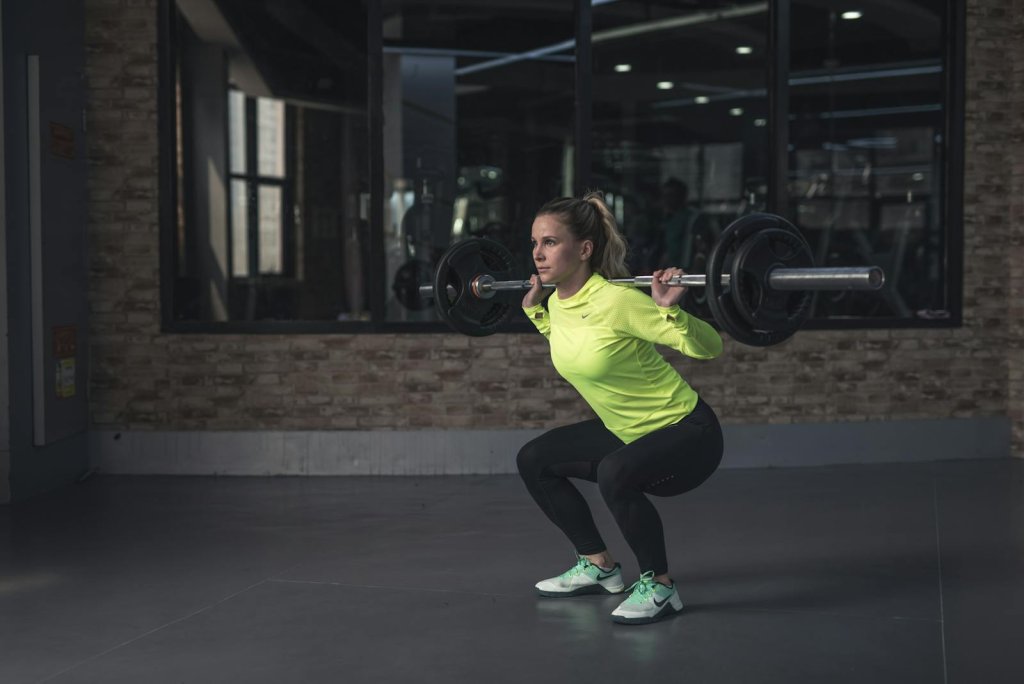
Understanding anaerobic exercise matters because it’s one of the most efficient ways to build lean muscle, improve explosive performance, and support fat loss in less time. Whether you’re lifting heavy, sprinting, or doing HIIT, anaerobic training helps you get stronger, faster, and fitter with short, intentional sessions.
In this guide, you’ll learn how anaerobic exercise works, its benefits, the best types of workouts, safety tips, real-world examples, and FAQs.
What Is Anaerobic Exercise?
Anaerobic exercise involves short, high-intensity bursts of movement that last from 10 to 120 seconds, using energy systems that do not rely on oxygen. Instead, your body uses stored ATP and muscle glycogen, making these workouts fast, powerful, and metabolically demanding.

How Anaerobic Exercise Differs From Aerobic Exercise
| Feature | Anaerobic | Aerobic |
|---|---|---|
| Oxygen Use | Not enough oxygen available | Uses oxygen |
| Duration | 10–120 seconds | Several minutes to hours |
| Intensity | High to maximal | Low to moderate |
| Primary Goals | Strength, power, speed | Endurance, heart health |
| Examples | Sprints, heavy lifting, HIIT | Jogging, cycling, swimming |
Both are important—but anaerobic exercise is what builds power, strength, and rapid muscular gains.
Benefits of Anaerobic Exercise
Anaerobic exercise creates powerful whole-body adaptations.

1. Builds Strength & Muscle
Short, explosive efforts stimulate fast-twitch muscle fibers, promoting increased muscle size and strength. This is why weight training, sprinting, and plyometrics are foundational for athletic and physique development.
2. Increases Power & Speed
Anaerobic training is essential for developing:
- Faster acceleration
- Higher jump height
- Stronger lifts
- Better athletic performance in short bursts
3. Supports Fat Loss
Because anaerobic workouts elevate your metabolism and increase post-exercise calorie burn, they may help reduce body fat when paired with consistent training and healthy nutrition.
4. Boosts Cardiovascular Fitness
High-intensity interval training (HIIT)—a form of anaerobic work—has been shown to improve VO₂ max as effectively as longer aerobic sessions, often in less time.
5. Enhances Metabolic Health
Consistent anaerobic training may help:
- Improve insulin sensitivity
- Increase lean mass
- Improve overall metabolic function
Types of Anaerobic Exercise
Anaerobic training covers a wide range of short, high-intensity movements designed to build strength, speed, power, and muscular endurance. Below is an expanded breakdown of the most effective anaerobic exercise categories, plus examples and benefits for each.
1. Sprinting
Sprinting is one of the purest forms of anaerobic exercise. These short, all-out bursts activate fast-twitch muscle fibers and dramatically improve leg power and acceleration.
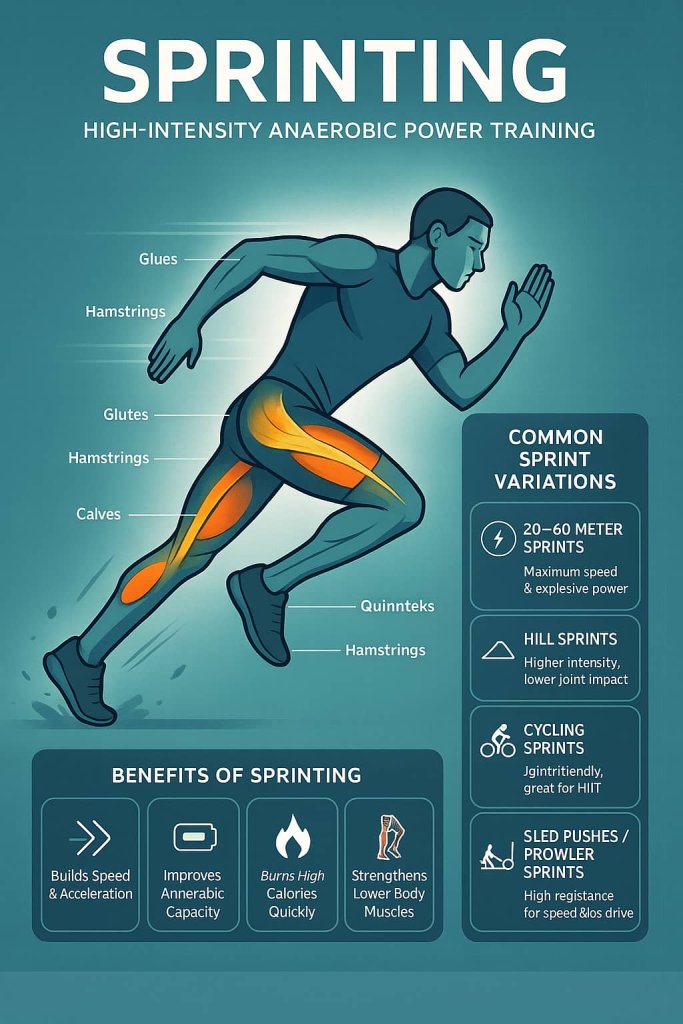
Common Sprint Variations:
- 20–60 meter sprints: Ideal for maximum speed and explosive output.
- Hill sprints: Increase intensity, build lower-body strength, and reduce joint impact.
- Cycling sprints: Safe for beginners or people with joint sensitivity; excellent for HIIT intervals.
- Rowing sprints: Full-body power intervals that improve anaerobic capacity and core strength.
- Sled pushes or prowler sprints: High-resistance bursts that improve speed and leg drive.
Benefits:
- Builds speed, acceleration, and power
- Improves anaerobic capacity and lactate tolerance
- Burns high calories in short time
- Strengthens major lower-body muscles
2. Heavy Resistance Training
Heavy strength training relies heavily on anaerobic energy systems because the effort is intense and performed in low repetitions. It is one of the most efficient ways to increase muscle size, strength, and power.

Anaerobic Strength Training Examples:
- Squats: Front squats, back squats, goblet squats
- Deadlifts: Conventional, sumo, trap-bar
- Bench Press: Barbell or dumbbell variations
- Pull-ups/Chin-ups: Weighted or strict reps
- Weighted Carries: Farmer’s carry, suitcase carry, yoke walks
- Overhead Press: Barbell or dumbbell
Training Features:
- Moderate to heavy loads (70–90% of 1RM)
- Low repetitions (3–8 per set)
- Long rest periods (2–3 minutes for recovery)
Benefits:
- Increases lean muscle mass
- Enhances strength and power output
- Stimulates fast-twitch muscle fibers
- Improves bone health and functional strength
3. Plyometric Training
Plyometrics involve explosive jumping or rebounding movements. They improve power, athleticism, coordination, and nervous system efficiency.
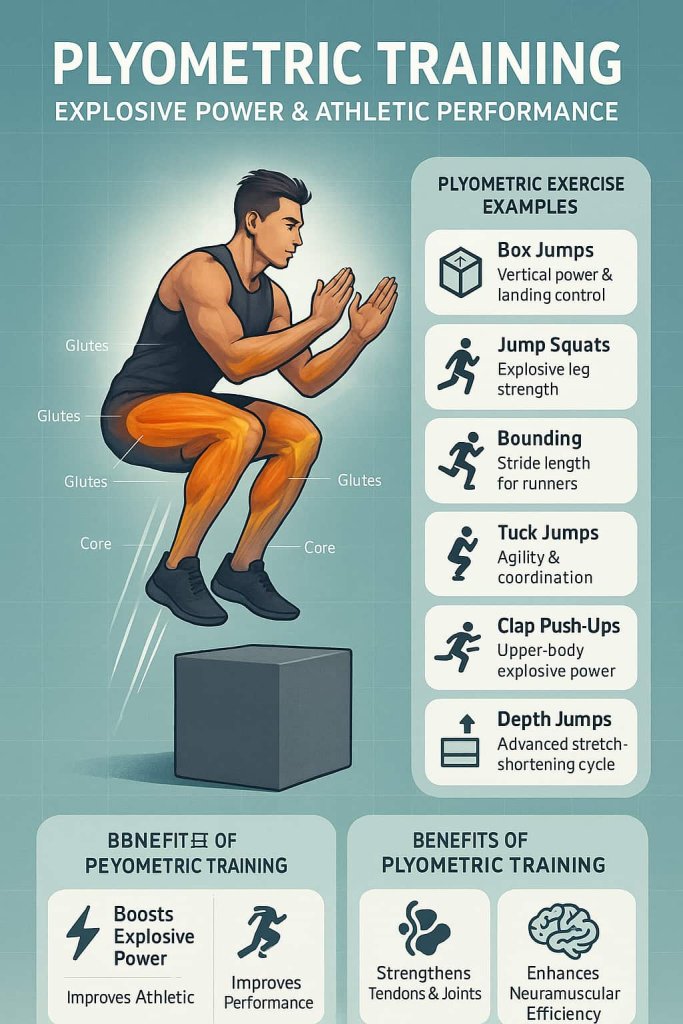
Plyometric Exercise Examples:
- Box jumps – For vertical power and landing mechanics
- Jump squats – Builds explosive leg strength
- Bounding – Improves stride length for runners
- Tuck jumps – Enhances speed, agility, and coordination
- Clap push-ups – Explosive upper-body power
- Depth jumps – Advanced plyometrics for elite athletes
Benefits:
- Boosts explosive power and jumping ability
- Enhances athletic performance in sports
- Strengthens tendons, ligaments, and joints
- Improves neuromuscular efficiency
4. HIIT (High-Intensity Interval Training)
HIIT combines short bursts of intense work with strategic recovery periods. Most HIIT training uses anaerobic pathways because the effort is near maximal.
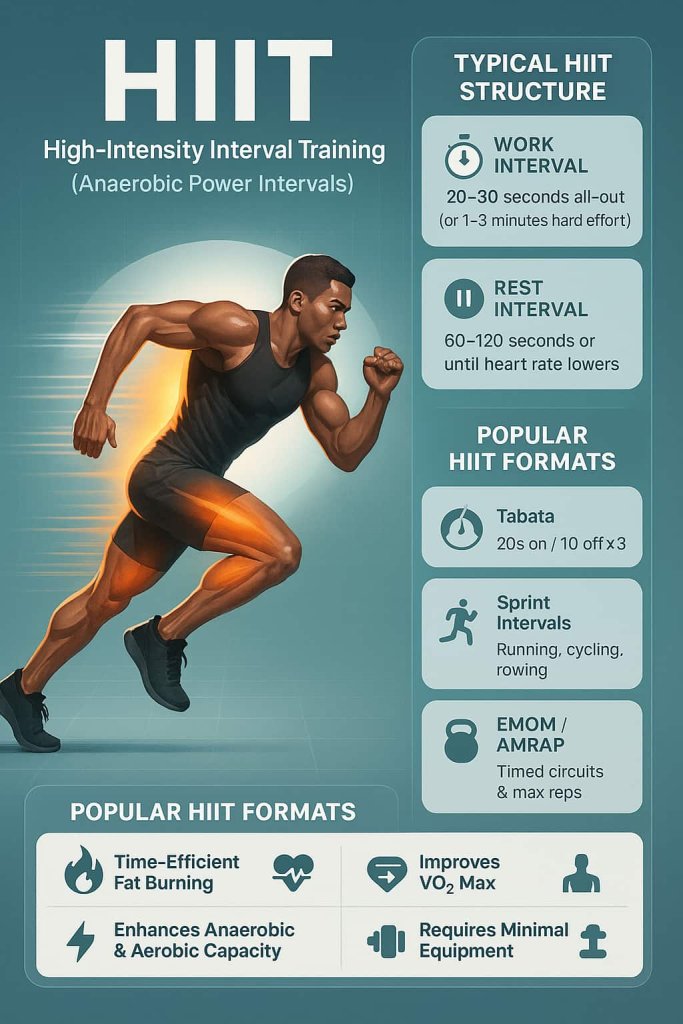
Typical HIIT Structure:
- Work: 20–30 seconds all-out (or 1–3 minutes hard effort)
- Rest: 60–120 seconds or until heart rate lowers
- Rounds: 5–10 depending on intensity
Popular HIIT Formats:
- Tabata: 20 seconds on, 10 seconds off, repeated 8 times
- Sprint intervals: Running, cycling, or rowing
- Circuit HIIT: Burpees, kettlebell swings, jump lunges
- EMOM/AMRAP: Intense circuits done for time or reps
Benefits:
- Time-efficient fat burning
- Improves VO₂ max and cardiovascular health
- Enhances anaerobic and aerobic capacity
- Can be done with equipment or bodyweight only
5. Combat-Sport Movements
Combat-style anaerobic exercises involve fast, explosive bursts of power and are commonly used by fighters, athletes, and anyone training for speed and reaction time.
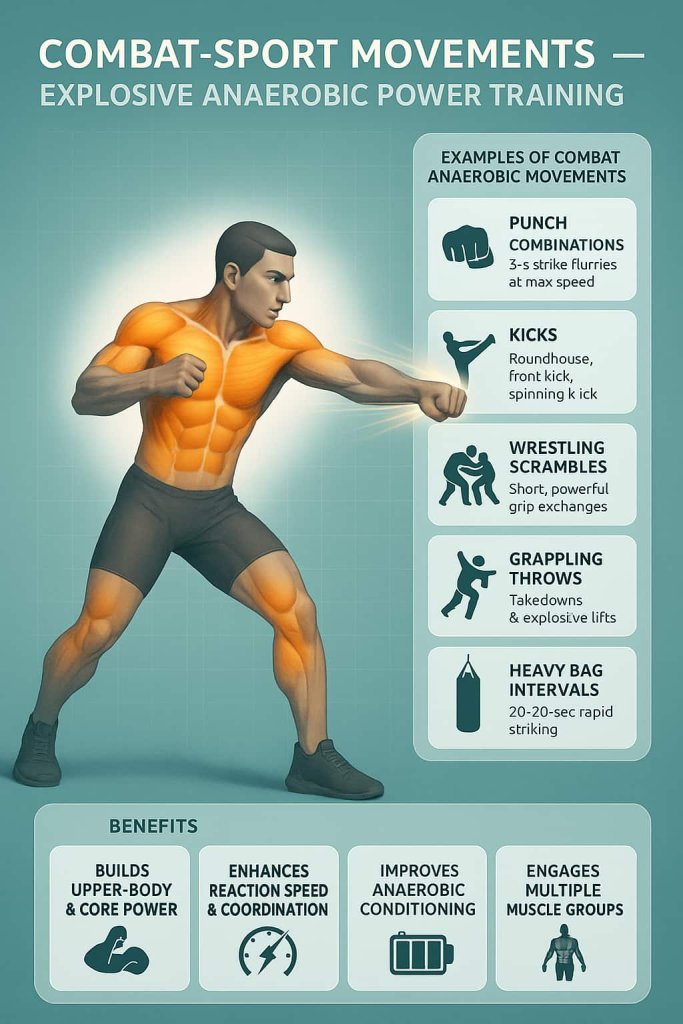
Examples of Anaerobic Combat Movements:
- Punch combinations: 3–5 punch flurries at max speed
- Kicks: Roundhouse kicks, front kicks, spinning kicks
- Wrestling scrambles: Short, powerful exchanges of grip and body control
- Grappling throws: Hip throws, takedowns, and explosive lifts
- Heavy bag intervals: 20–30 seconds of rapid strikes
Benefits:
- Builds upper-body and core power
- Enhances reaction speed and coordination
- Improves anaerobic conditioning for sports
- Engages multiple muscle groups simultaneously
6. Sports-Specific Anaerobic Drills (Optional Expanded Category)
Many sports naturally include anaerobic bursts, making these drills excellent for cross-training.
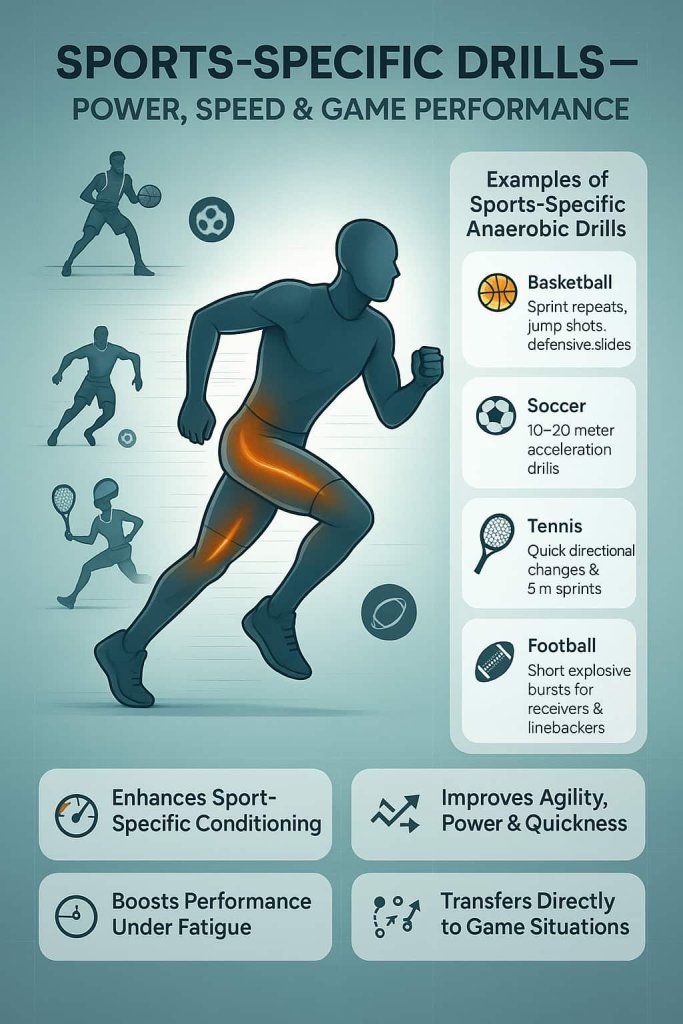
Examples:
- Basketball: Repeated sprint drills, jump shots, defensive slides
- Soccer: 10–20 meter acceleration drills
- Tennis: Quick directional changes and 5-meter sprints
- Football: Short explosive bursts for receivers and linebackers
Benefits:
- Increases sport-specific conditioning
- Improves agility, power, and quickness
- Helps athletes perform better under fatigue
7. Power-Based Kettlebell Training (Optional Expanded Category)
Kettlebell power movements rely on hip drive and explosive output, making them highly anaerobic.
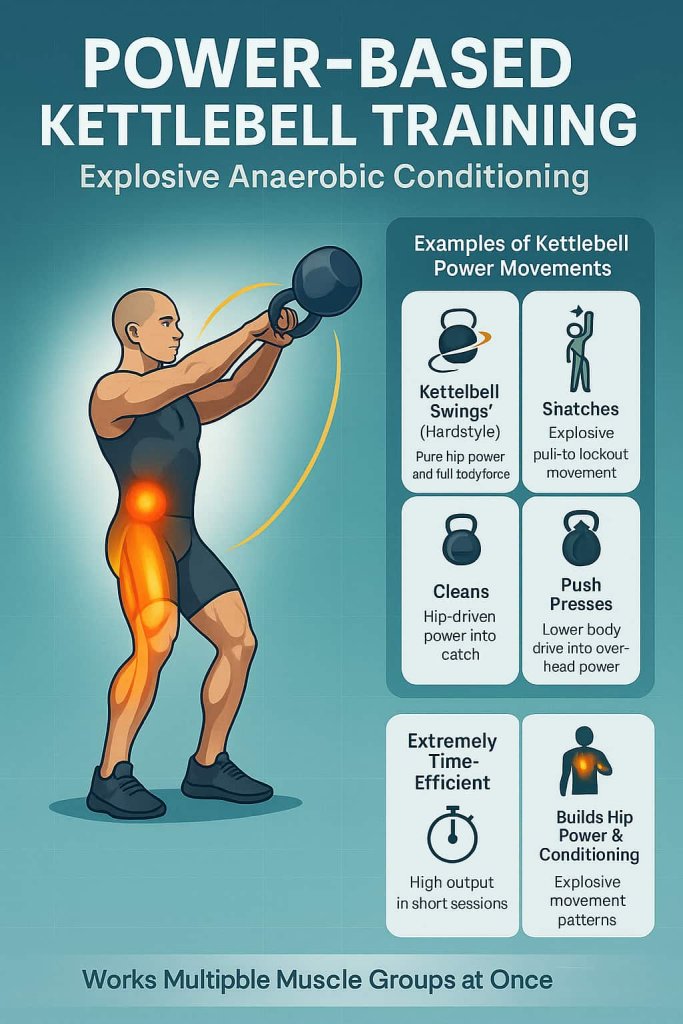
Examples:
- Kettlebell swings (hardstyle)
- Snatches
- Cleans
- Push presses
Benefits:
- Extremely time-efficient
- Builds hip power and conditioning
- Works multiple muscle groups at once
How Much Anaerobic Exercise Should You Do?
The right amount depends on your fitness level.

Beginners
- 1 HIIT or anaerobic session per week
- 1–2 strength-training sessions per week
- Gradually increase effort and volume
Intermediate
- 2–3 anaerobic sessions per week
- Alternate between strength, sprints, and HIIT
Advanced
- 3+ targeted anaerobic sessions weekly
- Include sprint intervals, heavy lifting, and plyometrics
Spacing sessions 48–72 hours apart helps recovery.
How to Do Anaerobic Exercise (Training Structure)
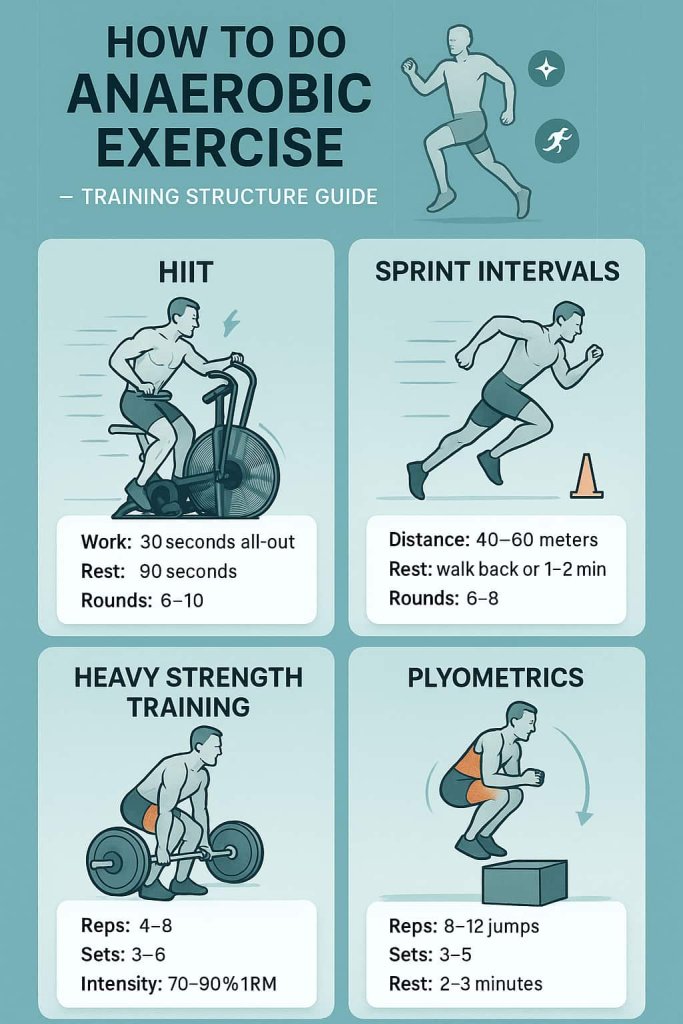
A. HIIT Format Example
- Work: 30 seconds all-out
- Rest: 90 seconds
- Rounds: 6–10
B. Sprint Format
- Distance: 40–60 meters
- Rest: walk back or 1–2 minutes
- Rounds: 6–8
C. Strength Training Example
- Reps: 4–8
- Sets: 3–6
- Intensity: 70–90% of 1RM
- Rest: 2–3 minutes
D. Plyometrics Example
- Reps: 8–12 jumps
- Sets: 3–5
- Rest: 2–3 minutes
Warm-Up Before Anaerobic Exercise
A warm-up prepares your joints and muscles for high-intensity work:
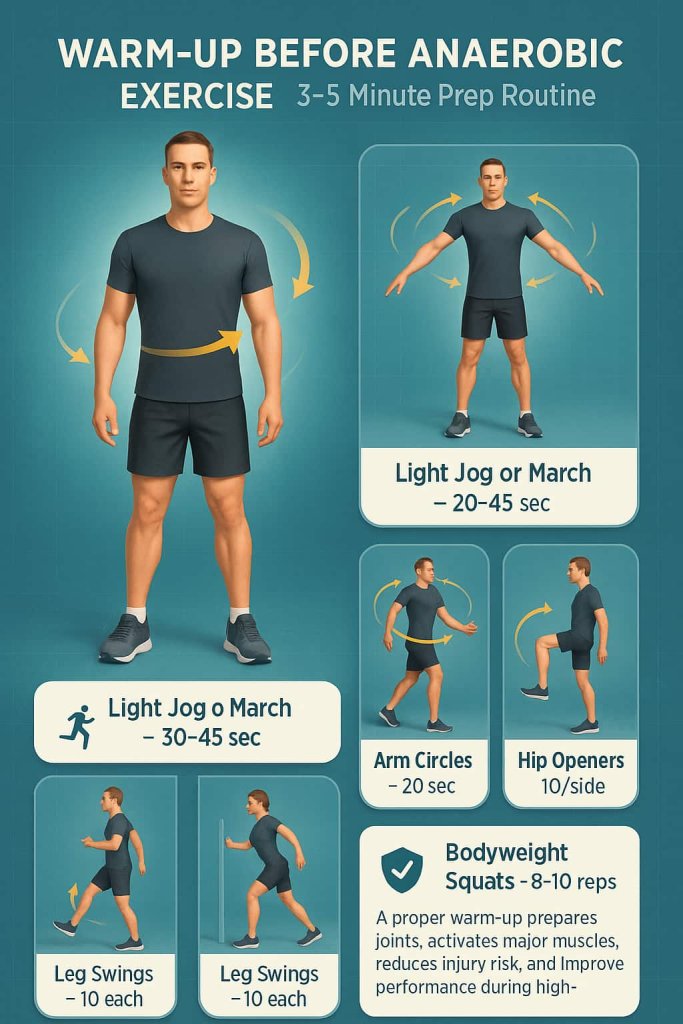
Quick 3–5 Minute Warm-Up
- Light jogging or marching – 30–45 seconds
- Arm circles – 20 seconds
- Hip openers – 10 each side
- Leg swings – 10 each
- Bodyweight squats – 8–10 reps
A proper warm-up reduces injury risk and improves performance.
Safety Tips & Who Should Avoid Anaerobic Exercise
Anaerobic exercise is demanding. Use caution if:
- You are new to exercise
- You have high blood pressure or heart disease
- You experience dizziness, chest pain, or unusual shortness of breath
General Safety Guidelines
- Warm up properly
- Start with low volume
- Use proper form
- Allow full recovery between sessions
- Stay hydrated
- Stop if you feel pain
If you have medical conditions, consult a healthcare provider before starting high-intensity training.
Cost & Accessibility
Anaerobic exercise can fit any budget.
Gym Options
Most gyms offer free weights, machines, and space for HIIT.
Typical price ranges: $10–$70/month, depending on location and gym type.
Class Options
HIIT or bootcamp-style classes generally cost $10–$30 per session.
Home Training (Budget-Friendly)
- Bodyweight workouts: Free
- Resistance bands: $10–$25
- Dumbbells/kettlebells: $20–$80
You can train anaerobically almost anywhere.
FAQ
1. Is anaerobic exercise better than aerobic exercise?
Neither is “better”—they target different systems. Anaerobic builds strength and power; aerobic improves endurance and heart health.
2. Does anaerobic exercise burn fat?
Yes, it supports fat loss by increasing metabolism and building lean mass, especially when combined with proper nutrition.
3. How long should anaerobic workouts be?
Most sessions last 10–30 minutes because intensity is high.
4. Can beginners do anaerobic training?
Yes, but start slowly with low-volume HIIT or beginner-friendly strength training.
5. Is HIIT considered anaerobic?
Yes. Most HIIT intervals rely on anaerobic energy systems, especially when performed near maximal effort.
6. Does anaerobic exercise build muscle?
Yes. It stimulates fast-twitch muscle fibers and supports strength and hypertrophy.
7. How many times per week should I do anaerobic exercise?
Most people benefit from 1–3 sessions per week, depending on experience and recovery.
Conclusion
Anaerobic exercise is one of the most efficient ways to build strength, power, and conditioning in a short amount of time. With explosive intervals, heavy lifting, or HIIT, you can rapidly improve fitness, support fat loss, and enhance overall performance. Start gradually, focus on technique, and incorporate regular recovery for best results.
Ready to begin? Start with one anaerobic workout this week and build from there.
References
- Garber CE, et al. (2011). “Quantity and Quality of Exercise for Developing and Maintaining Cardiorespiratory, Musculoskeletal, and Neuromotor Fitness in Apparently Healthy Adults: ACSM Position Stand.” Medicine & Science in Sports & Exercise.
Core guideline paper for how much moderate/vigorous and strength work adults should do.
https://pubmed.ncbi.nlm.nih.gov/21694556/ - World Health Organization (2020, updated). “Physical Activity.”
Global recommendations (150–300 min moderate or 75–150 min vigorous + strength), ideal for your guidelines/safety sections.
https://www.who.int/initiatives/behealthy/physical-activity - American Heart Association (2024). “Recommendations for Physical Activity in Adults.”
Very important YMYL authority to support health/safety, intensity, and who should be cautious.
https://www.heart.org/en/healthy-living/fitness/fitness-basics/aha-recs-for-physical-activity-in-adults - Poon ETC, et al. (2024). “Efficacy of Interval Training in Improving Body Composition Compared with Moderate-Intensity Continuous Training.” Sports Medicine.
Strong evidence that interval (anaerobic-style) training can improve body composition vs MICT – perfect for your fat-loss claims.
https://link.springer.com/article/10.1007/s40279-024-02070-9 - Danković G, et al. (2025). “Effects of High-Intensity Interval Training on Physical Fitness and Body Composition in Recreationally Active Females: A Systematic Review and Meta-Analysis.” Scientific Reports.
Supports VO₂max and body-composition benefits of HIIT, especially relevant to “fastest way to build strength, power & fat loss.”
https://www.nature.com/articles/s41598-025-11809-x - Binmahfoz A, et al. (2025). “Effect of Resistance Exercise on Body Composition, Muscle Strength and Physical Function During Weight Loss.” BMJ Open Sport & Exercise Medicine.
Key proof that resistance (anaerobic) training preserves lean mass and improves strength while supporting fat loss.
https://bmjopensem.bmj.com/content/11/3/e002363 - Wiens L, et al. (2025). “Does High-Intensity Interval Training Increase Muscle Mass and Strength?” Sports.
Review showing HIIT/sprint intervals can improve fat-free mass and strength—great support for your “strength & power” messaging.
https://www.mdpi.com/2075-4663/13/9/293 - Verdicchio C, et al. (2023). “A Clinical Guide for Assessment and Prescription of High-Intensity Interval Training.” Journal of Science and Medicine in Sport.
Excellent source for programming structure, warm-up, intensity, and safety—perfect for your “How to structure,” “Warm-up,” and “Safety” H2s.
https://www.sciencedirect.com/science/article/pii/S1443950623042142
